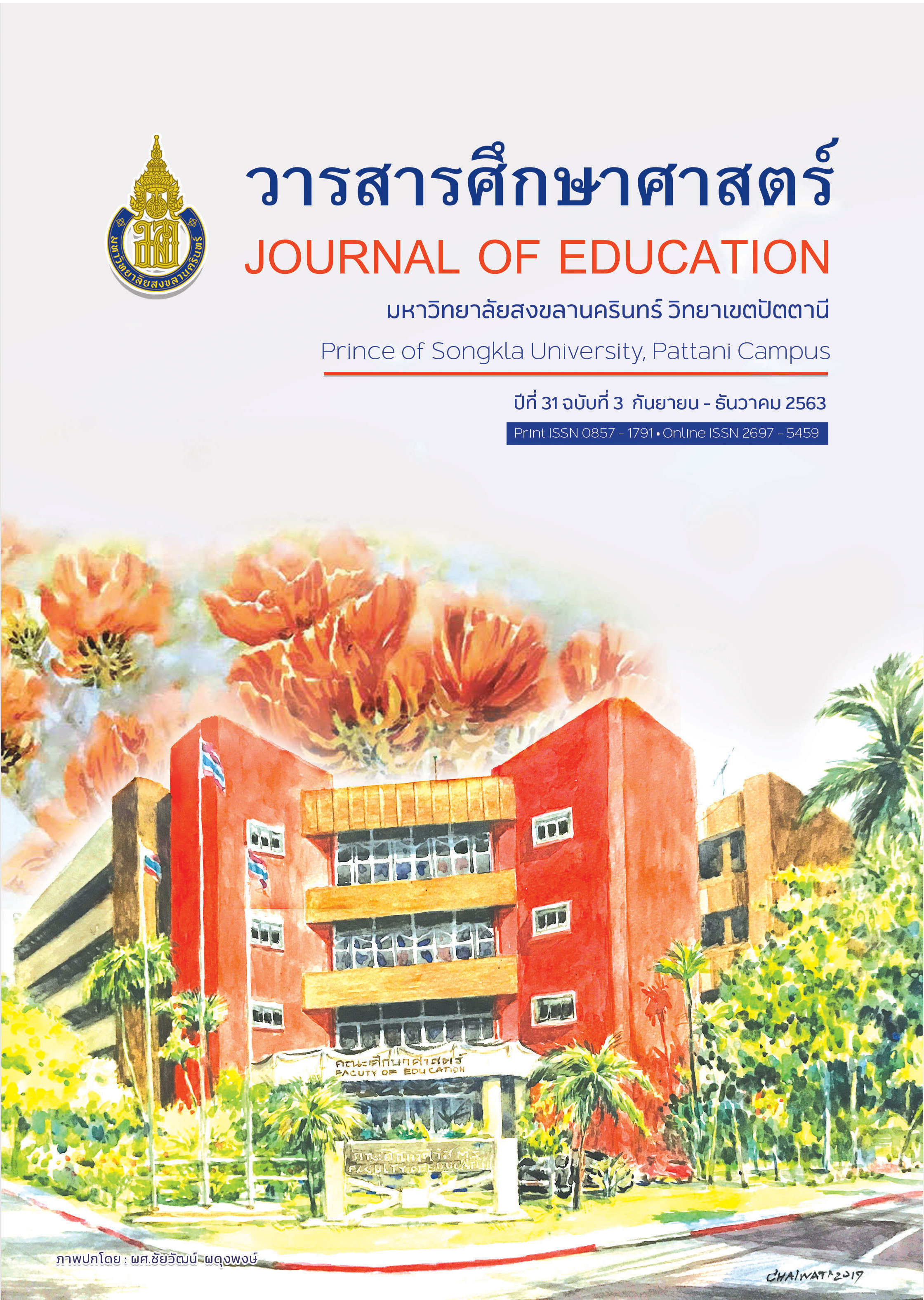ความรู้เนื้อหาผสานวิธีสอนการคิดเชิงนามธรรมสำหรับการคิดเชิงคำนวณ
Main Article Content
บทคัดย่อ
นับเป็นยุคใหม่ของการจัดการเรียนรู้ ที่ครูต้องสอนในสิ่งที่ไม่เคยเรียนและไม่เคยมีประสบการณ์มาก่อน การคิดเชิงคำนวณไม่ใช่ทักษะใหม่ หากแต่เพิ่งได้รับความสนใจในแวดวงการศึกษาในช่วงสิบกว่าปีที่ผ่านมา ในอดีตการคิดเชิงคำนวณเป็นทักษะเฉพาะของคนในแวดวงที่ทำงานเกี่ยวกับการใช้คอมพิวเตอร์ในการแก้ปัญหาต่าง ๆ แต่ในปัจจุบันทักษะนี้นับว่าเป็นทักษะพื้นฐานสำหรับนักเรียนทุกคนตั้งแต่ระดับประถมศึกษา การเปลี่ยนแปลงนี้นำมาซึ่งความท้าทายในการสอนของครู โดยเฉพาะอย่างยิ่งการสอนการคิดเชิงนามธรรมซึ่งเป็นหัวใจของทักษะการคิดเชิงคำนวณ การพัฒนาการคิดเชิงนามธรรมนั้นต้องอาศัยการฝึกฝนผ่านประสบการณ์ การเรียนรู้ที่หลากหลาย ครูเป็นส่วนสำคัญที่ช่วยพัฒนาทักษะดังกล่าวให้เกิดขึ้นกับผู้เรียน ครูต้องใช้วิจารณญาณในการเลือกสื่อและกิจกรรมที่มีอยู่มากมายอย่างเหมาะสมเพื่อสร้างสิ่งแวดล้อมในการเรียนรู้ที่ส่งเสริมการคิด เชิงนามธรรม บทความนี้นำเสนอความรู้เนื้อหาผสานวิธีสอนสำหรับครูในการพัฒนาการคิดเชิงนามธรรมสำหรับการคิดเชิงคำนวณ ซึ่งได้บูรณาการการใช้ทฤษฎีการเรียนรู้กับความเข้าใจทางวิทยาการคำนวณเพื่อสังเคราะห์แนวทางปฏิบัติในการจัดการเรียนรู้ ซึ่งจะช่วยครูสามารถจัดการเรียนรู้โดยมีเป้าหมายที่ชัดเจนและนำไปสู่การพัฒนาทักษะการคิดเชิงนามธรรมสำหรับการคิดเชิงคำนวณ
Article Details
เอกสารอ้างอิง
Aho, A. V. (2012). Computation and computational thinking. Computer Journal, 55(7), 833–835.
Beilin, H., & Pufall, P. B. (2013). Piaget’s theory: prospects and possibilities. Psychology Press.
Bell, T., Alexander, J., Freeman, I., & Grimley, M. (2009). Computer Science Unplugged: school students doing real computing without computers. The New Zealand Journal of Applied Computing and Information Technology, 13(1), 20–29.
Brennan, K., & Resnick, M. (2012). New frameworks for studying and assessing the development of computational thinking. AERA, 1-25.
Case, R. (1992). Neo-Piagetian theories of child development. In R. J. Sternberg & C. A. Berg (Eds.), Intellectual Development (pp. 161–196).
Curzon, P., Bell, T., Waite, J., & Dorling, M. (2019). Computational Thinking. In S. A. Fincher & A. V. Robins (Eds.), The Cambridge Handbook of Computing Education Research (pp. 513–546).
Denning, P. J. (2017). Remaining trouble spots with computational thinking. Communications of the ACM, 60(6), 33–39.
Ginsburg, H. P., & Opper, S. (1988). Piaget’s Theory of Intellectual Development. In Education. International Psychotherapy Institute.
Jevons, W. S. (1870). XXII. On the mechanical performance of logical inference. Philosophical transactions of the Royal Society of London, (160), 497-518.
Keereerat, C. (2019). Using the Problem-Solving and App Inventor to Develop Computational Thinking Skill for High School Students. Journal of Education Studies, 2, 31–47.
Korkmaz, Ö., Çakir, R., & Özden, M. Y. (2017). A validity and reliability study of the computational thinking scales (CTS). Computers in Human Behavior, 72.
Lister, R. (2011, January). Concrete and other neo-Piagetian forms of reasoning in the novice programmer. In Proceedings of the Thirteenth Australasian Computing Education Conference-Volume 114 (pp. 9-18). Australian Computer Society, Inc.
Nabb, K., Hofacker, E. B., Ernie, K., & Ahrendt, S. (2018). Using the 5 Practices in Mathematics Teaching. The Mathematics Teacher, 111(5), 366–373.
Papert, S. (1980). Mindstroms: children, computers, and powerful ideas. New York: Basic Books, Inc.
Phongsasithorn, A., Laosinchai, P., & Nokkaew, A. (2019). Sorted: An Educational Digital Game for Learning Sorting Algorithms. In Proceedings of the International Symposium on Education and Psychology 2019. Knowledge Association of Taiwan.
Priami, C. (2007). Computational thinking in biology. Lecture Notes in Computer Science (Including Subseries Lecture Notes in Artificial Intelligence and Lecture Notes in Bioinformatics), 4780 LNBI, 63–76.
Shulman, L. S. (1986). Those Who Understand: Knowledge Growth in Teaching. Educational Researcher, 15(2), 4– 14.
Stein, M. K., Engle, R. A., Smith, M. S., & Hughes, E. K. (2008). Orchestrating Productive Mathematical Discussions: Five Practices for Helping Teachers Move Beyond Show and Tell. Mathematical Thinking and Learning, 10(4), 313-340.
SupaDaow. (2019). Unplugged Data Science for High School เข้าใจวิทยาศาสตร์ข้อมูลก่อนพุ่งตัวไปที่ AI. Retrieved from HACK yourself website: https://everyhackilearn.wordpress.com/2019/11/30/ unplugged-data-science-for-high-school-เข้าใจวิทยาศาสตร์/
Vygotsky, L. S. (1978). Mind in Society: The Development of Higher Psychological Processes . American Anthropologist, 81. https://doi.org/10.1525/aa.1979.81.4.02a00580
Wing, J. M. (2006). Computational Thinking. Communications of the ACM, 49(3), 33–35.
Wing, J. M. (2008). Computational thinking and thinking about computing. Philosophical Transactions of the Royal Society A: Mathematical, Physical and Engineering Sciences, 366(1881), 3717–3725. https://doi.org/10.1098/rsta.2008.0118
Wing, J. M. (2011). Research notebook: Computational thinking—What and why? The Link Magazine, June 23, 2015.Retrieved from http://www.cs.cmu.edu/link/research-notebook-computational-thinking-what-and-why


